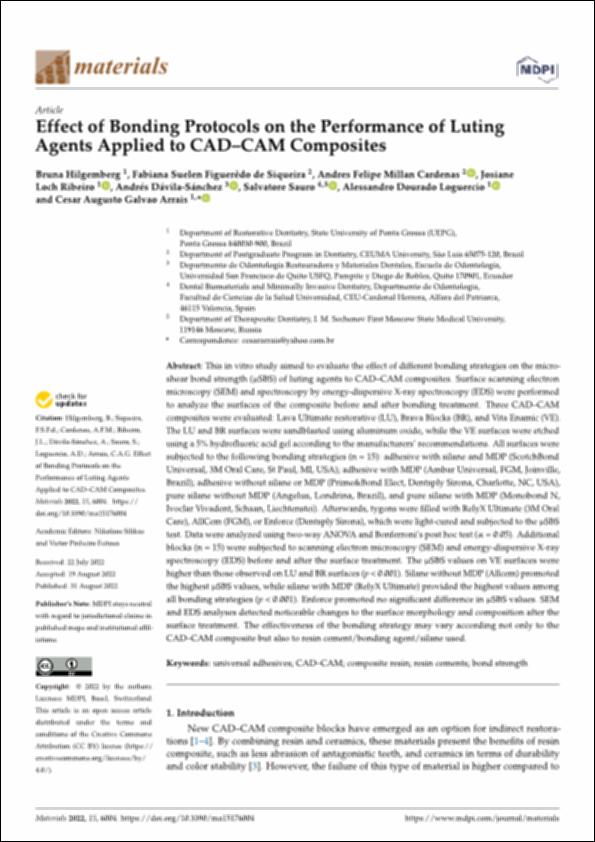Por favor, use este identificador para citar o enlazar este ítem:
http://hdl.handle.net/10637/14361Effect of bonding protocols on the performance of luting agents applied to CAD-CAM composites
| Título : | Effect of bonding protocols on the performance of luting agents applied to CAD-CAM composites |
| Autor : | Hilgemberg, Bruna Figueredo de Siqueira, Fabiana Suelen Millan Cardenas, Andres Felipe Ribeiro, Josiane Loch Dávila Sánchez, Andrés Sauro, Salvatore. Loguercio, Alessandro D. Galvao Arrais, Cesar Augusto |
| Materias: | Gomas y resinas sintéticas - Aplicaciones en Odontología.; Gums and resins, synthetic in Dentistry.; Materiales dentales.; Cementos dentales.; Adhesivos dentales.; Dental adhesives.; Dental cements.; Dental materials. |
| Editorial : | MDPI |
| Citación : | Hilgemberg, B., Siqueira, F. S. F., Cardenas, A. F. M., Ribeiro, J. L., Dávila-Sánchez, A., Sauro, S., Loguercio, A. D. & Arrais, C. A. G. (2022). Effect of bonding protocols on the performance of luting agents applied to CAD-CAM composites. Materials, vol. 15, i. 17 (31 aug.), art. 6004. DOI: https://doi.org/10.3390/ma15176004 |
| Resumen : | This in vitro study aimed to evaluate the effect of different bonding strategies on the microshear bond strength ( SBS) of luting agents to CAD–CAM composites. Surface scanning electron microscopy (SEM) and spectroscopy by energy-dispersive X-ray spectroscopy (EDS) were performed to analyze the surfaces of the composite before and after bonding treatment. Three CAD–CAM composites were evaluated: Lava Ultimate restorative (LU), Brava Blocks (BR), and Vita Enamic (VE). The LU and BR surfaces were sandblasted using aluminum oxide, while the VE surfaces were etched using a 5% hydrofluoric acid gel according to the manufacturers’ recommendations. All surfaces were subjected to the following bonding strategies (n = 15): adhesive with silane and MDP (ScotchBond Universal, 3M Oral Care, St Paul, MI, USA); adhesive with MDP (Ambar Universal, FGM, Joinville, Brazil); adhesive without silane or MDP (Prime&Bond Elect, Dentsply Sirona, Charlotte, NC, USA), pure silane without MDP (Angelus, Londrina, Brazil), and pure silane with MDP (Monobond N, Ivoclar Vivadent, Schaan, Liechtenstei). Afterwards, tygons were filled with RelyX Ultimate (3M Oral Care), AllCem (FGM), or Enforce (Dentsply Sirona), which were light-cured and subjected to the SBS test. Data were analyzed using two-way ANOVA and Bonferroni’s post hoc test ( = 0.05). Additional blocks (n = 15) were subjected to scanning electron microscopy (SEM) and energy-dispersive X-ray spectroscopy (EDS) before and after the surface treatment. The SBS values on VE surfaces were higher than those observed on LU and BR surfaces (p < 0.001). Silane without MDP (Allcem) promoted the highest SBS values, while silane with MDP (RelyX Ultimate) provided the highest values among all bonding strategies (p < 0.001). Enforce promoted no significant difference in SBS values. SEM and EDS analyses detected noticeable changes to the surface morphology and composition after the surface treatment. The effectiveness of the bonding strategy may vary according not only to the CAD–CAM composite but also to resin cement/bonding agent/silane used. |
| Descripción : | Este artículo se encuentra disponible en la siguiente URL: https://www.mdpi.com/1996-1944/15/17/6004 Este artículo de investigación pertenece al número especial "The Search for Real Biologically Active Dental Materials of the Future". |
| URI : | http://hdl.handle.net/10637/14361 |
| Derechos: | http://creativecommons.org/licenses/by/4.0/deed.es |
| ISSN : | 1996-1944 (Electrónico) |
| Idioma: | es |
| Fecha de publicación : | 31-ago-2022 |
| Centro : | Universidad Cardenal Herrera-CEU |
| Aparece en las colecciones: | Dpto. Odontología |
Los ítems de DSpace están protegidos por copyright, con todos los derechos reservados, a menos que se indique lo contrario.


